The Ford Mustang Ecoboost is having a bit of trouble. Australia is going slightly Mustang mad, but virtually all the adulation is centred on the big, bad V8.
If the GT is the full forward on the high school footy team, the Ecoboost is the geeky younger brother in chess club; with only half the number of cylinders to offer, it’s lacking a little street cred among the enthusiast crowd, one particularly witty friend on Facebook even dubbing it ‘Mustang Silly’.
The scepticism is easy to understand. Ford first introduced a four-cylinder Mustang in 1974 in response to the oil crisis – with a 66kW 2.3-litre four-pot lifted from the Pinto, it had about as much muscle as Arnold Schwarzenegger’s little finger.
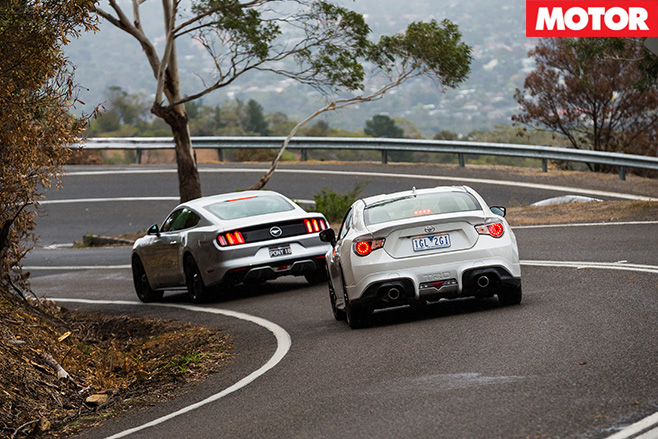
Certainly the mechanical specification is a bit healthier this time around. As with its 1974 predecessor, the engine is a 2.3-litre four-cylinder, but thanks to a turbocharger and plenty of 21st century technology it produces almost four times the power: 233kW at 5600rpm and 432Nm at 3000rpm. Combined with a $45,990 price tag (auto adds $2500) the four-pot Mustang offers an impressive amount of bang for your buck.
So impressive, in fact, that finding a suitable rival for context is difficult. Nissan 370Z? Too old and, at $56,930, too expensive. Volkswagen Scirocco R? Too front-drive. Peugeot RCZ?
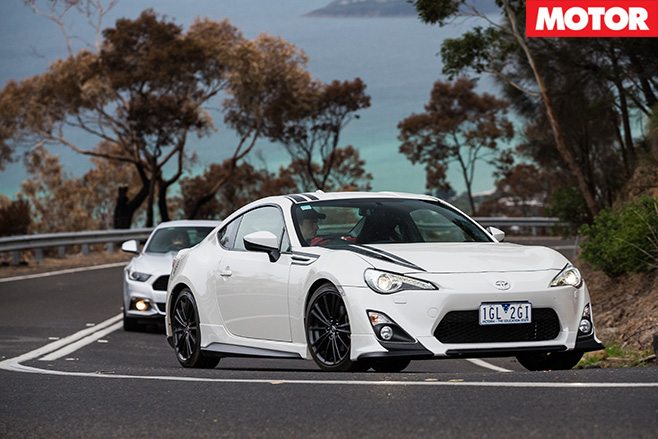
Our test car is the $37,990 Blackline Edition, released to celebrate the arrival of the one-make 86 Racing Series. Limited to 450 units – 250 manuals and 200 automatics – it scores a TRD bodykit, black exterior stripes and an interior that looks like the set of a Quentin Tarantino film, with a Kill Bill-style splash of red to the seats, steering wheel, gear knob, handbrake and door grips.
The overall effect is a bit garish, but it does lift the ambience without detracting from the 86’s perfect driving position. Sadly, it doesn’t improve its outdated infotainment system, which is set to be upgraded as part of the Toybaru’s MY2017 update. The cabin is a functional affair, but feels almost plush in comparison to the Mustang. The Ford’s interior design is a strange mix of retro muscle car cues (the chrome toggle switches, aircraft-inspired dials) and shared Ford technology (SYNC2 infotainment), but the quality of the materials leaves a lot to be desired.
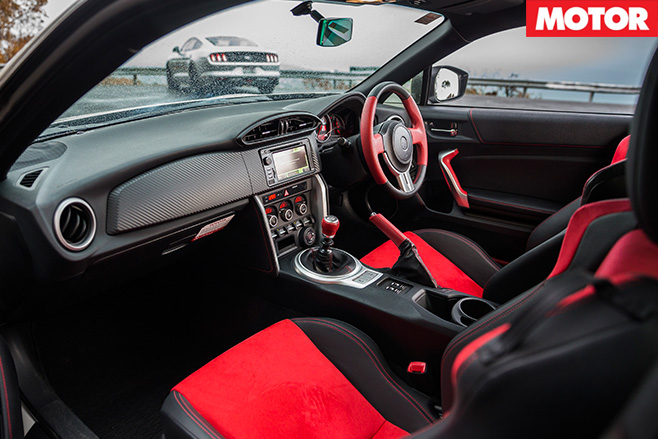
But you know what? It doesn’t really matter. Yes, the interior feels cheap, but relatively speaking, this is a cheap car. Certainly no other car at this price point attracts this amount of attention. Despite its popularity, it seems the novelty of seeing a Mustang on Aussie roads hasn’t abated.
In contrast, the 86 might as well be invisible. The Blackline’s monochrome colour scheme does add some manga-style cool, but it would need to be covered in $100 notes to attract a crowd like the Mustang. Even non-enthusiasts stop, stare and comment, and are much less likely to notice the missing ‘5.0’ badge on the front guards, evidence you’re only packing half the expected number of cylinders.
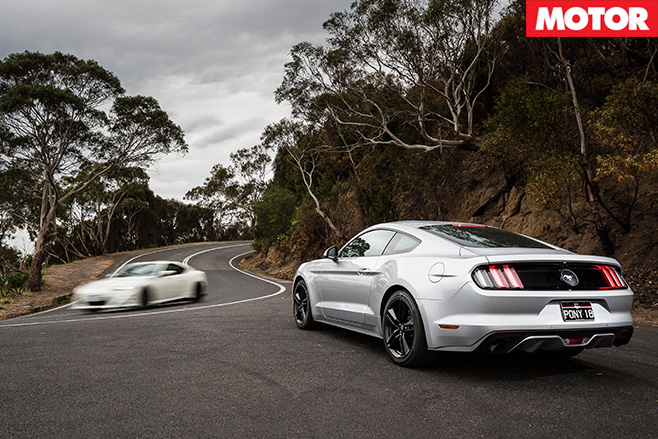
Soundtrack aside, however, the Ecoboost acquits itself pretty well. A broad swell of strong mid-range torque delivers ample acceleration, the 0-100km/h sprint completed in 6.08sec and the quarter mile in 14.24sec at 159.07km/h, similar numbers to a Golf GTI. Extracting the final tenth or two is hard work, but the six-speed manual is a good match, with reasonably short ratios and a shift action that’s like a notchier version of a Mazda MX-5.
Whether it’s better than the Toyota’s six-speed manual is likely to be a matter of personal preference. The 86’s ’box is notchy and obstinate when cold, but the shift action improves markedly once warm, which is just as well as it needs frequent use to keep the high-revving but torque-lite atmo 2.0-litre on the boil. There’s enough urge down low around 2000rpm to make day-to-day use painless, but then there’s a massive hole in the power delivery until it picks up again at around 5500rpm.
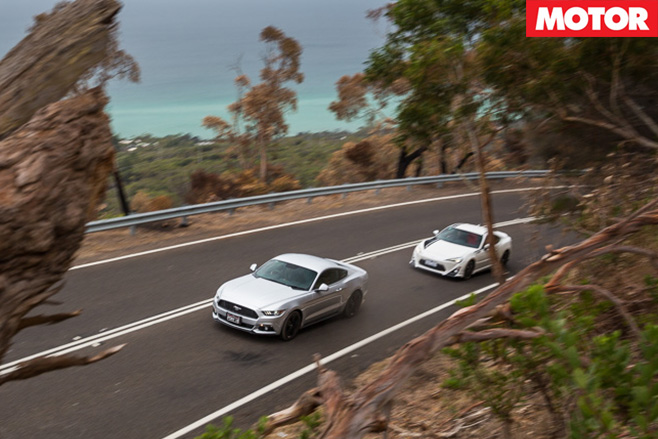
It may lack outright grunt, but the 86 can still be a handful, particularly in the wet. In slippery conditions, the Michelin Primacy low-rolling resistance tyres have about as much grip as a bar of soap with even moderate throttle openings slewing the rear end sideways. With VSC activated, this results in a loud graunch as the electronics clumsily step in, while it requires a quick armful of opposite lock with the stability control off.
This might sound like a lot of fun, and it is to a degree, especially as it can occur at hilariously low speeds, but the way the eco-spec tyres relinquish grip can be quite sudden, even in the dry. What the 86 really needs is rubber with the outright grip of an eco-tyre, but the smoother breakaway characteristics of a performance tyre. The lack of grip costs it under brakes, the firm pedal feel undermined by early ABS intervention, which pushes its 100-0km/h stopping distance out to 39.1m – 2.3m more than the much heavier Mustang.
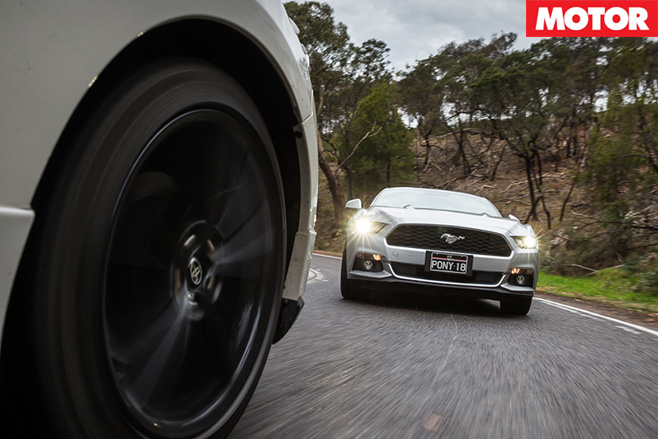
At this point you’re probably expecting the fat American to cop a pasting, its soft suspension and near-400kg weight disadvantage making it about as talented in the corners as a three-wheeled shopping trolley. Nothing could be further from the truth. It’ll surprise no-one to hear that the Mustang’s size and weight make it less agile than the lithe 86, but there is a seriously talented chassis underneath that Hollywood styling.
It doesn’t provide the same level of feedback as the Toyota, but counters with incredibly benign handling, making the Mustang an extremely friendly car when driven hard. It’s not playful as such, but it is engaging and much better than you’d expect it to be. Its soft setup makes the limit a slope rather than an edge and in the dry you can use the throttle like a switch, nailing it once the front has bitten, safe in the knowledge there is more traction than torque.
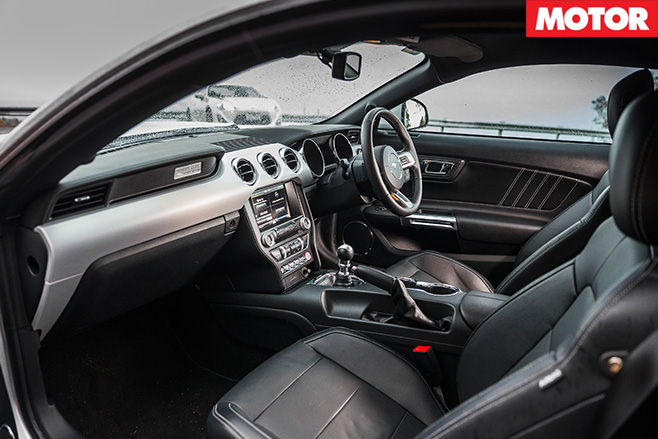
Its Ecoboost engine might not be particularly inspiring, but the amount of grunt available feels like a perfect match for the chassis. In fact, the whole car feels very balanced. Each part feels nicely in tune with every other part – until you get out and look at it.
It’s a difficult thing to explain, but the Ecoboost doesn’t feel like you expect a Mustang to feel. You drive it, it’s enjoyable, but then can’t help feeling vaguely disappointed that the experience doesn’t quite match up to the looks.
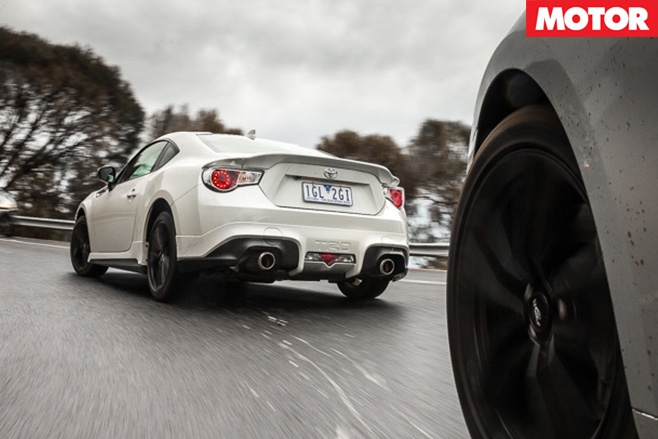
If you want a four-cylinder sports coupe, buy a Toyota 86. However, maybe wait for the new one that’s due later in 2016 which chief engineer Tetsuya Tada promises is an enormous improvement over the current car (which we’ve driven this issue, p20). If that’s the case, we should be in for a treat. While the current model is beginning to show a few cracks, it’s still about the best fun you can have on four wheels.
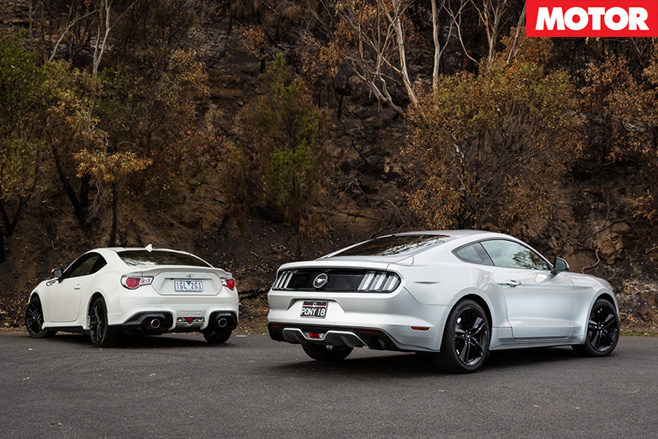
DRAG BATTLE
| u00a0 | FORD MUSTANG ECOBOOSTu00a0u00a0 | u00a0TOYOTA 86 |
| 0-10km/h | u00a00.37 | 0.55 |
| 0-20km/h | 0.80u00a0 | 1.13u00a0 |
| 0-30km/h | 1.24u00a0 | 1.69u00a0 |
| 0-40km/h | 1.71u00a0 | 2.14u00a0 |
| 0-50km/h | 2.20u00a0 | 2.62u00a0 |
| 0-60km/h | 2.96u00a0 | 3.39u00a0 |
| 0-70km/h | 3.67 | 4.19u00a0 |
| 0-80km/h | 4.29 | 5.07u00a0 |
| 0-90km/h | 5.01u00a0 | 6.01 |
| 0-100km/h | 6.08u00a0 | 7.15u00a0 |
| 0-110km/h | 7.08u00a0 | 8.38u00a0 |
| 0-120km/h | 8.13u00a0 | 9.69u00a0 |
| 0-130km/h | 9.38u00a0 | 11.09u00a0 |
| 0-140km/h | 11.05u00a0 | 12.86u00a0 |
| 0-150km/h | 12.71u00a0 | 14.74u00a0 |
| 0-400m | 14.24sec @ 159.07km/hu00a0 | 15.15sec @ 152.10km/hu00a0 |
| 80-120km/h (3rd-6th) | 3.8/5.2/6.5/8.7secu00a0 | 5.7/7.6/9.5/12.8secu00a0 |
| 100-0km/hu00a0 | 36.8mu00a0 | 39.1mu00a0 |
| SPEED IN GEARS 1st | 60km/h @ 6500rpmu00a0 | 59km/h @ 7400rpm |
| 2nd | 100km/hu00a0@ 6500rpmu00a0 | 97km/hu00a0@ 7400rpm |
| 3rd | 153km/hu00a0@ 6500rpmu00a0 | 138km/hu00a0@ 7400rpm |
| 4th | 205km/hu00a0@ 6500rpmu00a0 | 175km/hu00a0@ 7400rpm |
| 5th | 240km/h @ 6150rpm*u00a0 | 213km/hu00a0@ 7400rpm |
| 6th | 240km/hu00a0@ 5110rpm*u00a0 | 226km/h @ 6020rpm* |
| u00a0 | *u00a0Manufacturer’s claim | u00a0 |
As tested by MOTOR: Heathcote Dragway, 1:23pm, 19 degrees, dry, driver Scott Newman
SPECS
| u00a0 | FORD MUSTANG ECOBOOSTu00a0 | u00a0TOYOTA 86 |
| Body | u00a02-door, 2+2-seat coupe | 2-door, 2+2-seat coupe |
| Drive | rear-wheel | rear-wheel |
| Engine | 2261cc inline-4, DOHC, 16v, turbocharger | 1998cc flat-4, DOHC, 16v |
| Bore/Stroke | 87.6 x 94.0mm | 86.0 x 86.0mm |
| Compression | 9.5:1 | 12.5:1u00a0 |
| Power | 233kW @ 5600-5700rpm | 147kW @ 7000rpm |
| Torque | 432Nm @ 3000rpm | 205Nm @ 6400-6600rpm |
| Power/Weight | 140kW/tonneu00a0 | 115kW/tonne |
| Transmission | 6-speed manual | 6-speed manual |
| Weight | 1666kg | 1275kg |
| Front Suspension | A-arms, coil springs, anti-roll bar | struts, coil springs, anti-roll bar |
| Rear Suspension | multi-links, coil springs, anti-roll bar | multi-links, coil springs, anti-roll bar |
| L/W/H | 4784/1916/1381mm | 4240/1775/1320mm |
| Wheelbase | 2720mm | 2570mm |
| Tracks | 1582/1655mm | 1520/1540mm |
| Steering | electrically-assisted rack-and-pinion | electrically-assisted rack-and-pinion |
| Front brakes | 352mm ventilated discs, 4-piston calipers | 277mm ventilated discs; single-piston calipers |
| Rear brakes | 330mm ventilated discs, single-piston calipers | 286mm solid discs, single-piston calipers |
| Wheels | 19.0 x 9.0-inch (f/r) | 17.0 x 7.0-inch (f/r) |
| Tyres | 255/40 R19 (f/r) Pirelli P Zero | 215/45 R17 (f/r) Michelin Primacy |
| Price as tested | $45,990 | $37,990 |
| Pros | Great handling; rock-star looksu00a0 | Playful chassis; superb steering; price |
| Cons | Engine lacks character; understeer | Crap tyres; about to be updatedu00a0 |
| Star Rating | u00a03.5/5 | u00a04/5 |






